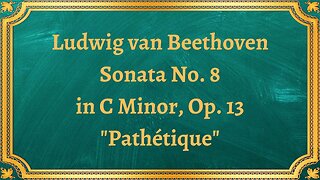Premium Only Content

Joseph Haydn Divertimento in G major
#JosephHaydn #DivertimentoInGmajor #ClassicalMusic #InstrumentalMusic #MusicHistory #MusicComposition #ChamberMusic #StringQuartet #NonTraditionalInstruments
Joseph Haydn's divertimentos are light-hearted pieces that were typically performed during social gatherings in the late 18th century. The Divertimento in G major is one of the most well-known works in this genre.
The Divertimento in G major is an instrumental piece that includes three movements. It starts with a cheerful and upbeat allegro in G major, followed by a contrasting andante in E minor. The final movement, a minuet in G major, is quick and rhythmic, finishing the piece with a sense of joyful exuberance.
The piece's light and whimsical nature is typical of the divertimento genre, and it showcases Haydn's playful and humorous style. The piece's structure, melody, and harmony are all executed with excellent precision, as expected from one of the most celebrated composers of his time.
The Divertimento in G major is not only a delightful piece of music but also a historically significant one. At the time the piece was composed, composers typically only wrote music for the aristocracy or the church. However, Haydn's involvement in the development of the string quartet and other instrumental works helped expand the audience for chamber music beyond the privileged classes.
This piece is unique and noteworthy for its use of unconventional instruments. For instance, the piece includes an unusual combination of instruments that includes two violins, a double bass, a horn, and two Lira Organizzatas (a type of hurdy-gurdy). Haydn's decision to incorporate these instruments speaks to his experimental and innovative approach to musical composition.
In conclusion, the Divertimento in G major by Joseph Haydn is a delightful and historically significant piece of music. It is a perfect example of Haydn's mastery of the divertimento genre, spanning three movements filled with musicality, wit, and humor. With its customized instrumentation and light-hearted nature, it is a standout piece of chamber music that will undoubtedly continue to delight audiences for centuries to come.
You have the opportunity to support the channel https://destream.net/live/RadSiarAl/donate
-
 18:29
18:29
Classical music_Music Inspiration
2 months agoLudwig van Beethoven Sonata No. 8 in C Minor, Op. 13 "Pathétique"
901 -
 12:01
12:01
T-SPLY
8 hours agoBREAKING - Jasmine Crockett Under Investigation For Fraudulent Campaign Donations
24K30 -
 39:07
39:07
Steph & Kayls
6 hours agoFrom Spicy Content to Sleepless Nights: The Chaos of Being First-Time Parents & Creators | Ep. 1
18.9K4 -
 1:36
1:36
Nick Shirley
8 hours ago $1.64 earnedThese Anti-Trump and Elon Protesters are Idiots
27.3K40 -
 17:08
17:08
World2Briggs
1 day ago $1.25 earned10 Worst Cities to Move if You Hate Yourself.
21.5K7 -
 13:32
13:32
megimu32
1 day agoKitKat vs. Twix: One Breaks, One Bites… Who Wins?
25.3K12 -
 24:04
24:04
Link to the Light
20 hours ago $0.27 earnedTop 10 Most Anticipated Games of 2025 - Link to the Light
15.6K3 -
 23:00
23:00
Ohio State Football and Recruiting at Buckeye Huddle
19 hours agoOhio State Football: Spring Game Recap | Biggest Concerns for Buckeyes?
10K -
 11:57
11:57
Fit'n Fire
6 hours ago $0.20 earnedGriffin Armament Dual-Lok HRT-762 First Looks
7.17K -
 11:23
11:23
ariellescarcella
1 day agoHere's What Happens To 'Trans Kids' : 15 Year Study Reveals ALL
6.43K19